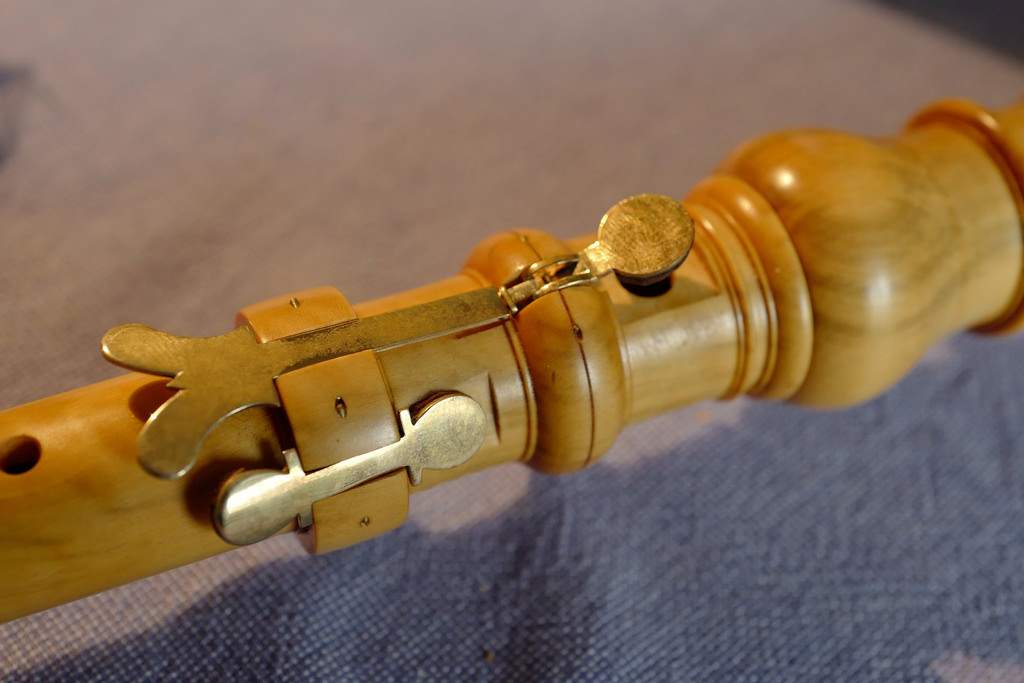Welcome to Harmonia. I’m Angela Mariani, inviting you to join me for the next hour, as today’s performers of medieval, renaissance and baroque music bring to life the music of the distant past.
“Musick will give our hardest Labours Ease;
The Hautboy charms in War, the Flute in Pease.
Where Love or Honour calls, these Sounds inspire;
This charms with Love, That Courage sets on fire.”
This hour on Harmonia, we explore what Playford describes as an honorable and courageous instrument: the oboe. Then, stay tuned for our featured release Confluence: the merging musical style of Central Europe and Venice, performed by Ensemble Collina.
[Theme music fades at :59]
MUSIC TRACK
Handel: Acis and Galatea (Original Cannons Performing Version 1718) HWV 49a
Dunedin Consort & Players / Dir. John Butt
Linn Records CKD319 2008 / B00BY2E540
George Friedrich Handel
Tr. 20 Act II: Aria: Love sounds th’ alarm (Acis) (4:50)
We heard “Love sounds th’ alarm” from Handel’s Acis and Galatea, performed by the Dunedin Consort and Players, directed by John Butt.
(Music fades at 5:00)
The baroque oboe that you hear in period performances of Bach and Rameau today remained largely unchanged from its development under Louis XIV in the late 17th century until the rise of the Classical oboe in the mid-18th century. Sometimes called the hautboy, it is an elegant double-reed instrument, with a wide conical bore, six finger holes (including two-twin holes) and two keys. The beautiful turnings on the instrument have lead some to say it looks like a pawn or bishop from a particularly elegant chess set.
Let’s hear two dances by André Danican Philidor, a man known for both his musical and his chess skills.
MUSIC TRACKS
Oboe Ensemble Arrangements – Philidor, Lully
London Oboe Band / Paul Goodwin, cond.
Harmonia Mundi HMU907122DI 1994 / B000QQRFS8
Le marriage de la grosse Cathos
Tr. 1 I. La Pavane – March (1:26)
Tr. 16 XVI. Pavane (:55)
Dances by André Danican Philidor, performed by the London Oboe Band, with Paul Goodwin directing.
Alongside the Philidor family, the Hotteterre family is credited for having made major contributions to the development of the baroque oboe. Though known primarily as a flute maker, Jacques-Martin Hotteterre also had a hand in creating the oboe. He worked as a composer and instrument maker in the court of Louis XIV of France, and his intimate works have been championed by recorder players, flutists, oboists, and violinists. Here is Hotteterre’s Prelude in D Major from “L’Art de préluder,” performed here on traverso, viola da gamba, and theorbo.
MUSIC TRACK
Inner Chambers: Royal Court Music of Louis XIV
Les Ordinaires / Leela Breithaupt (traverso), Erica Rubis (viola da gamba), David Walker (theorbo)
Naxos 8.573814 2018 / B077MYDX9F
Jacques Hotteterre
Tr. 1 L’Art de préluder, Op. 7: Prelude in D Major (4:20)
Les Ordinaires performed Hotteterre’s Prelude in D from “L’Art de préluder,” on their 2018 release Inner Chambers: Royal Court Music of Louis XIV.
Thanks to its early popularity with the French aristocracy, the oboe grew to become wildly popular throughout western Europe. Although Louis XIV may not have conquered all of Europe, the new woodwind instruments that were first heard at his court certainly did! Within 20 years of the baroque oboe’s debut, the new oboe could also be heard in Munich, Hanover, and Hamburg. Let’s hear an aria composed by oboist Agostino Steffani.
MUSIC TRACK
Del sonar pittoresco: Musical pleasures in the countryside at the time of Tiepolo
Baroque Ensemble Sans Souci
Dynamic CDS637 (2009) / B001URSZL8
Agostino Steffani
Tr. 16 Agostino Steffani / Chomigiola: Aria (3:05)
That was an aria by Agostino Steffani. We heard Ensemble Barocco Sans Souci, from their 2009 release Del sonar pitoresco.
You can become a fan of Harmonia Early Music on Facebook. Just search for Harmonia Early Music.
FLOATING BREAK: 18:30 – 19:00 (:30)
Lustige Feld-Music, Lingua Franca, Ricercar 2010, Tr. 2 Suite in A Minor: II. Entrée (excerpt of 1:33)
At the turn of the 18th century, the trumpet held pride of place among wind instruments in Europe. 18th century trumpet players were kind of the rock stars of their day. They were highly paid professionals, protected by their powerful guilds, whose instrument was inextricably linked with royalty in the public’s imagination.
Here is Heinrich Biber’s Sonata a 7 in C Major, featuring the Barocktrumpeten Ensemble Berlin.
MUSIC TRACK (Amazon mp3)
Tromba Hispanica
Barocktrumpeten Ensemble Berlin / Johann Plietzsch, dir.
Raumklang RK2906D2 (2012) / B00JYES7T4
Heinrich Ignaz Franz von Biber
Tr. 18 Heinrich Ignaz Franz von Biber / Sonata a 7 in C Major (5:21)
Biber’s Sonata a 7 in C Major performed by the Barocktrumpeten Ensemble Berlin.
Considering the important place that the trumpet held in musical society, it is significant that the author of the 1695 oboe method The Sprightly Companion defends the oboe, writing, in the flowery language of that time, “For besides its Inimitable charming Sweetness of Sound (when well play’d upon) it is also Magestical and Stately, and not much Inferiour to the Trumpet; and for that reason, the greatest Heroes of the age (who sometimes despise Strung-Instruments) are infinitely pleased with This [the oboe] for its brave and Sprightly Tone.”
Here are some oboes sounding first brave, then sprightly, and finally, sweet, in the opening section of the Sonata in G Minor by German composer and organist Johann Michael Müller.
MUSIC TRACK
Telemann, Fasch, Fischer, Müller: Lustige Feld-Music
Lingua Franca / Dir. Benoit Laurent
Ricercar RIC304 (2010) / B00HJGOX2Y
Müller: Sonata in G Minor
Tr. 7 I. Più adagio – Allegro – Adagio (1:48)
Lingua Franca performing the Sonata in G Minor by Johann Michael Müller. That was from their 2010 recording Lustige Feld-Music.
MIDPOINT BREAK:
Lully & Philidor: Ballet and Theater Music for Oboe Band, London Oboe Band, harmonia mundi 1994, Tr. 12 Air des Ivrognes, from Le Mariage de la Grosse Cathos (excerpt of 1:14)
One of the first baroque pieces that many oboe students encounter nowadays is the Sonata No. 1 in C minor from Handel’s set of Op. 8 sonatas. The piece was written for an apparently sprightly oboe player with the apt name, Galliard, who played at the Queen’s Theatre in London. Here is the first movement from Handel’s sonata No. 1 in C minor.
MUSIC TRACK
Handel, G.F.: Oboe Sonatas
Koji Ezaki (oboe) / with Yoko Miyazaki (violin), Tomoki Tai (cello), Kazuto Ito (harpsichord)
Fontek FOCD9578 (2013) / B00IA8VNNW
Handel: Oboe Sonata No. 1 in C minor, Op. 1, No. 8 HWV 366
Tr. 8 I. Largo (2:02)
The famous Largo from Handel’s oboe sonata no. 1 in C Minor. We heard Koji Ezaki, oboe and Kazuto Ito, harpsichord.
Handel also uses the oboe in his opus 3 Concerti Grossi. When performed by historically-informed ensembles today, audiences often have the opportunity to hear the type of rich ornamentation that was all the rage when this music was first performed. The Largo from Handel’s well-loved Concerto Grossi no. 2 from this collection opens with conversing cellos. The oboe soars above, with an aria-like solo for most of the movement. Here are the Largo and Allegro from Handel’s Concerti Grossi opus 3, number 2.
MUSIC TRACKS
Handel: Concerti Grossi, Op. 3, Nos. 1-6
Academy of Ancient Music / dir. Richard Egarr
Harmonia Mundi HMU907415DI 2006 / B000QZTK0A
Handel: Concerto Grosso in B-Flat Major, Op. 3, No. 2, HWV 313
Tr. 5 II. Largo (2:23)
Tr. 6 III. Allegro (2:14)
Total: 4:37
We heard the Largo and Allegro from Handel’s Concerto Grossi, opus 3, number 2. That was the Academy of Ancient Music, directed by Richard Egarr, featuring oboist Frank de Bruine.
But the oboe shines most brightly in Handel’s operas. In “Consider, fond shepherd,” from Acis and Galatea, the oboe first introduces the character Damon and later converses with him.
MUSIC TRACK
Handel: Acis and Galatea (Original Cannons Performing Version 1718) HWV 49a
Dunedin Consort & Players / Dir. John Butt
Linn Records CKD319 2008 / B00BY2E540
George Friedrich Handel
Tr. 21 Act II: Aria: Consider, fond shepherd (Damon) (6:42)
That was “Consider, fond shepherd,” featuring tenor Thomas Hobbs and oboist Alexandra Bellamy. John Butt leading the Dunedin Consort & Players in the 1718 version of Handel’s Acis and Galatea.
You can find hundreds of archived episodes, playlists, and podcasts online at harmonia early music dot org.
FLOATING BREAK MUSIC
Confluence: the merging musical styles of central Europe and Venice, Ensemble Collina, Acis 2017, Tr. 7 Sonata à 2 (excerpt of 3:11)
In the late 16th and early 17th centuries, Venice’s wealthy families poured money into supporting the arts, enabling the creation of a patchwork of rich musical traditions throughout western and central Europe. On our featured recording, Confluence: The Merging Styles of Central Europe and Venice, Ensemble Collina explores music of the early baroque period.
MUSIC TRACK
Confluence: the merging musical styles of central Europe and Venice
Ensemble Collina / Lea Peroutka (vln), Brent Wissick, (vla da gamba), Michael Kris (sackbut), Elaine Funaro (harpsichord/organ)
Acis 2017 / B071ZN7JYF
Tr. 5 Concerto Primo, Adam Jarzębski (2:58)
We heard music by the Polish composer Adam Jarzębski [AH-DAHM YO-JEHM-SKI].
Ensemble Collina is made up mostly of faculty members from the University of North Carolina, including string players Lea Peroutka and Brent Wissick, sackbut player Michael Kris, and keyboardist Elaine Funaro. The genesis for this recording emerged from a 2013 research trip to Europe by trombonist Michael Kris. This recording includes some rarely heard pieces by Andreas Oswald, who worked in Eisenach as well as Weimar, where Bach later worked. Let’s hear a Sonata à 3 in E Minor by Andreas Oswald.
MUSIC TRACK
Confluence: the merging musical styles of central Europe and Venice
Ensemble Collina / Lea Peroutka (vln), Brent Wissick, (vla da gamba), Michael Kris (sackbut), Elaine Funaro (harpsichord/organ)
Acis 2017 / B071ZN7JYF
Tr. 1 Sonata à 3 in E Minor, Andreas Oswald (8:20)
We heard a Sonata à 3 in E Minor by Andreas Oswald from our featured release, Confluence, by Ensemble Collina.
Learn more about recent early music releases on the Harmonia Early Music Podcast. You can subscribe on iTunes or at harmonia early music dot org.
(Fade in theme music)
Harmonia is a production of WFIU, and part of the educational mission of Indiana University. Additional resources come from the William and Gayle Cook Music Library at the Indiana University Jacobs School of Music.
We welcome your thoughts about any part of this program, or about early music in general. You can leave a comment or question any time by visiting harmonia early music dot org and clicking on "Contact."
The writer for this edition of Harmonia was Sarah Huebsch.
Thanks to our studio engineer Michael Paskash and our staff – Janelle Davis, Wendy Gillespie, and LuAnn Johnson. Additional technical support comes from KTTZ at Texas Tech University in Lubbock, Texas.
Our producer is Elizabeth Clark, our executive producer is John Bailey, and I’m Angela Mariani, inviting you to join us again for the next edition of Harmonia.










